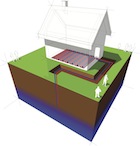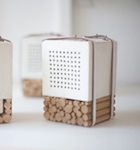Your approach to environmentally friendly design goes a lot further than simply sourcing materials from less than 500 miles away. What are some of the other sustainable elements in your home?
Russell Hruska: First of all, we pay close attention to the building orientation. It’s an easy way to dramatically affect heating and cooling in a house without costing more money. In the Live-Work Studio, we put most of the glass on the eastern façade, which is shaded by trees and overhangs, and we limited southern and western exposures to afternoon sun. We used operable windows throughout the home to capture the southeastern breeze. We have such good natural light that we typically don’t turn our lights on during the day.
Rame Hruska: We also place a great deal of importance in the honesty of materials. That means we leave exposed what a lot of builders would cover up so we use less material. For example, we left the pine subflooring exposed, which serves as the ceiling for the first-floor gallery space and finished flooring on the second floor. Not having superfluous decorative elements—and using fewer materials—takes up fewer resources.
How does the Live-Work Studio fit into an existing Houston neighborhood?
Rame: Even though our work is very contemporary, we want to preserve the older homes and the character of the streets in our neighborhood. We’ve been strategic about where to provide new urban infill. Our projects preserve green space and address the scale and rhythm of the streetscape. We want to be change-makers, but we’re very mindful of trying to integrate into the existing fabric.
How does your home encourage a sense of community in your neighborhood?
Rame: When we moved into this neighborhood in 2006, it was still considered very transitional. Since then, we’ve built 10 houses and have land for six more. We’ve created a shared community space and an organic garden in the green space connecting the homes, so we get together over glasses of wine and let the kids play. This spring we harvested over 60 pounds of tomatoes for our neighbors and ourselves.
Russell: The people who buy our homes are diverse in terms of ages and ethnicities, but there’s a real like-mindedness in terms of sustainability and community. The change in our neighborhood in just a few years is really remarkable, and we want to continue to make a difference to this community.
As architects designing and building your own home, you must have had high standards for yourself. What sorts of challenges, obstacles, or issues did you encounter?
Russell: We had great ideas and a limited budget, but I think we did a good job of achieving something fantastic. We share a philosophy about the underlying notions of design—being honest about the materials, the way we use structure and appropriate scale; we both have that same sense. We might argue about individual details, but that underlying sense puts us in line with each other and the rest of our office. ABQ







